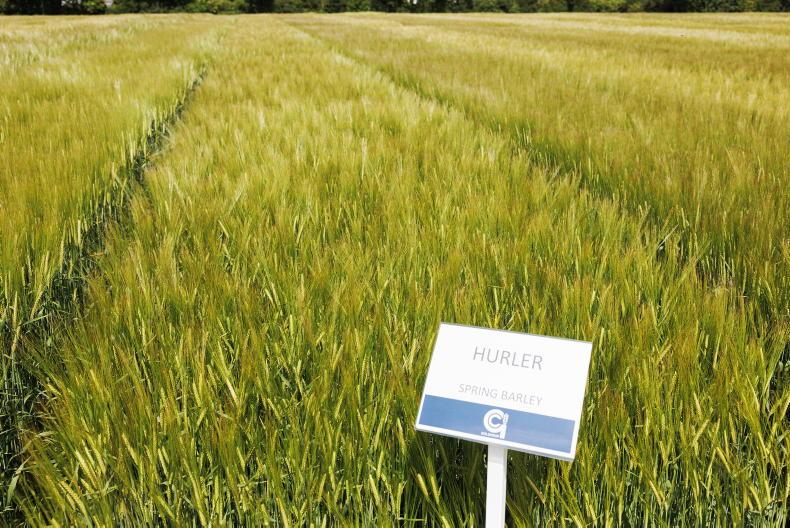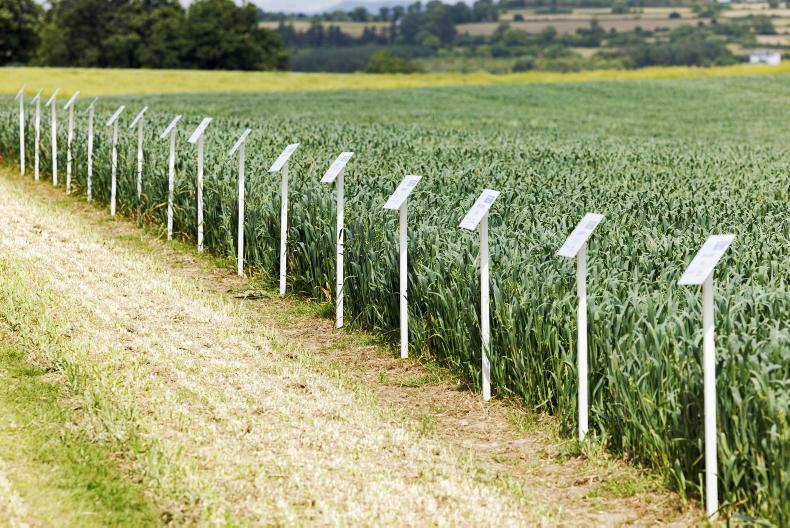It will not come as any surprise that the first fungicide has been delayed in this spring barley crop in what has been a record wet May.
Weeds are now well under control as they were sprayed in the first week of May and the T1 fungicide would have gone on at the end of tillering had weather allowed.
The main stems are now at GS31. The crop is clean and there were no early signs of disease, so once conditions allow fungicide will be applied. This will most likely be a mix of Decoy (prothioconazole) and Comet (pyraclostrobin) at 0.5l/ha each.
The crop has been treated twice already for manganese deficiency - at sowing using a seed dressing and with Wolftrax Manganese with the herbicide.
A mix of salts may be applied with the T1 fungicide, depending on how growth is looking. Weather can stress the crop and salts contain small amounts of a broad range of nutrients, which may help in tough growth conditions.

Checking the growth stage of this spring barley crop.
This field does not need a wild oat spray, but crops which do need to be treated should be sprayed with Axial Pro as soon as possible and rates may need to be increased (0.6l/ha) depending on the problem. If canary grass is an issue, a full rate of 0.8l/ha will be needed.
Crop stress needs to be minimised to help prevent Ramularia. Preventing disease is important so crops planted at the end of March and early April, which are nearing the end of tillering, will benefit from a fungicide as soon as possible to keep disease away and protect tillers.
Any nutrient deficiencies should also be treated at this time.
The wet weather is likely to show up a lot of problems so seek advice if you are unsure of the nutrition required.
Variety: Planet.Sowing date: 23 March.Growth stage: GS31.T1 fungicide may include:
Decoy (prothioconazole) at 0.5l/ha.Comet (pyraclostrobin) at 0.5l/ha.Epso Combitop at 2kg/ha.
It will not come as any surprise that the first fungicide has been delayed in this spring barley crop in what has been a record wet May.
Weeds are now well under control as they were sprayed in the first week of May and the T1 fungicide would have gone on at the end of tillering had weather allowed.
The main stems are now at GS31. The crop is clean and there were no early signs of disease, so once conditions allow fungicide will be applied. This will most likely be a mix of Decoy (prothioconazole) and Comet (pyraclostrobin) at 0.5l/ha each.
The crop has been treated twice already for manganese deficiency - at sowing using a seed dressing and with Wolftrax Manganese with the herbicide.
A mix of salts may be applied with the T1 fungicide, depending on how growth is looking. Weather can stress the crop and salts contain small amounts of a broad range of nutrients, which may help in tough growth conditions.

Checking the growth stage of this spring barley crop.
This field does not need a wild oat spray, but crops which do need to be treated should be sprayed with Axial Pro as soon as possible and rates may need to be increased (0.6l/ha) depending on the problem. If canary grass is an issue, a full rate of 0.8l/ha will be needed.
Crop stress needs to be minimised to help prevent Ramularia. Preventing disease is important so crops planted at the end of March and early April, which are nearing the end of tillering, will benefit from a fungicide as soon as possible to keep disease away and protect tillers.
Any nutrient deficiencies should also be treated at this time.
The wet weather is likely to show up a lot of problems so seek advice if you are unsure of the nutrition required.
Variety: Planet.Sowing date: 23 March.Growth stage: GS31.T1 fungicide may include:
Decoy (prothioconazole) at 0.5l/ha.Comet (pyraclostrobin) at 0.5l/ha.Epso Combitop at 2kg/ha. 









SHARING OPTIONS